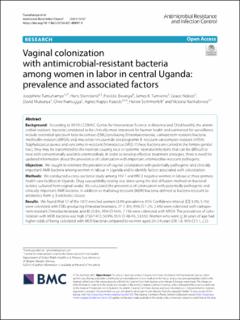| dc.contributor.author | Tumuhamye, Josephine | |
| dc.contributor.author | Steinsland, Hans | |
| dc.contributor.author | Bwanga, Freddie | |
| dc.contributor.author | Tumwine, James K. | |
| dc.contributor.author | Ndeezi, Grace | |
| dc.contributor.author | Mukunya, David | |
| dc.contributor.author | Namugga, Olive | |
| dc.contributor.author | Napyo, Agnes Kasede | |
| dc.contributor.author | Sommerfelt, Halvor | |
| dc.contributor.author | Nankabirwa, Victoria | |
| dc.date.accessioned | 2022-02-02T13:36:35Z | |
| dc.date.available | 2022-02-02T13:36:35Z | |
| dc.date.created | 2021-09-30T18:28:05Z | |
| dc.date.issued | 2021 | |
| dc.identifier.issn | 2047-2994 | |
| dc.identifier.uri | https://hdl.handle.net/11250/2976685 | |
| dc.description.abstract | Background
According to WHO ( CISMAC. Centre for Intervention Science in Maternal and Child health), the antimicrobial resistant bacteria considered to be clinically most important for human health and earmarked for surveillance include extended-spectrum beta-lactamase (ESBL)-producing Enterobacteriaceae, carbapenem-resistant bacteria, methicillin-resistant (MRSA) and, macrolide-lincosamide-streptogramin B -resistant vancomycin-resistant (VRSA) Staphylococcus aureus and vancomycin-resistant Enterococcus (VRE). If these bacteria are carried in the female genital tract, they may be transmitted to the neonate causing local or systemic neonatal infections that can be difficult to treat with conventionally available antimicrobials. In order to develop effective treatment strategies, there is need for updated information about the prevalence of colonization with important antimicrobial-resistant pathogens.
Objective
We sought to estimate the prevalence of vaginal colonization with potentially pathogenic and clinically important AMR bacteria among women in labour in Uganda and to identify factors associated with colonization.
Methods
We conducted a cross-sectional study among HIV-1 and HIV-2 negative women in labour at three primary health care facilities in Uganda. Drug susceptibility testing was done using the disk diffusion method on bacterial isolates cultured from vaginal swabs. We calculated the prevalence of colonization with potentially pathogenic and clinically important AMR bacteria, in addition to multidrug-resistant (MDR) bacteria, defined as bacteria resistant to antibiotics from ≥ 3 antibiotic classes.
Results
We found that 57 of the 1472 enrolled women (3.9% prevalence; 95% Confidence interval [CI] 3.0%, 5.1%) were colonized with ESBL-producing Enterobacteriaceace, 27 (1.8%; 95% CI 1.2%, 2.6%) were colonized with carbapenem-resistant Enterobacteriaceae, and 85 (5.8%; 95% CI 4.6%, 7.1%) were colonized with MRSA. The prevalence of colonization with MDR bacteria was high (750/1472; 50.9%; 95% CI 48.4%, 53.5%). Women who were ≥ 30 years of age had higher odds of being colonized with MDR bacteria compared to women aged 20–24 years (OR 1.6; 95% CI 1.1, 2.2).
Conclusion
Most of the women included in our study were vaginally colonized with potentially pathogenic MDR and other clinically important AMR bacteria. The high prevalence of colonization with these bacteria is likely to further increase the incidence of difficult-to-treat neonatal sepsis. | en_US |
| dc.language.iso | eng | en_US |
| dc.publisher | BMC | en_US |
| dc.rights | Navngivelse 4.0 Internasjonal | * |
| dc.rights.uri | http://creativecommons.org/licenses/by/4.0/deed.no | * |
| dc.title | Vaginal colonization with antimicrobial-resistant bacteria among women in labor in central Uganda: prevalence and associated factors | en_US |
| dc.type | Journal article | en_US |
| dc.type | Peer reviewed | en_US |
| dc.description.version | publishedVersion | en_US |
| dc.rights.holder | Copyright The Author(s) 2021 | en_US |
| dc.source.articlenumber | 37 | en_US |
| cristin.ispublished | true | |
| cristin.fulltext | original | |
| cristin.qualitycode | 1 | |
| dc.identifier.doi | 10.1186/s13756-021-00897-9 | |
| dc.identifier.cristin | 1941665 | |
| dc.source.journal | Antimicrobial Resistance and Infection Control | en_US |
| dc.relation.project | Norges forskningsråd: 223269 | en_US |
| dc.identifier.citation | Antimicrobial Resistance and Infection Control. 2021, 10, 37. | en_US |
| dc.source.volume | 10 | en_US |

